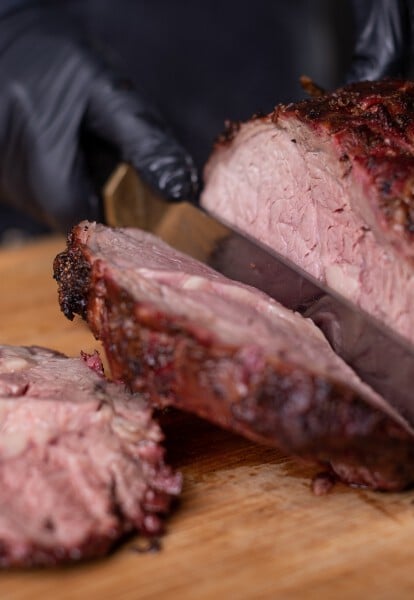
THE BOOK OF PRIME RIB
The prime rib roast
One of the holiday season's most sought after cuts of meats-prime rib-also happens to be one of the most expensive cuts of meat. Due to its unmistakable taste and tenderness, prime rib is often considered a luxury. And, behind every costly price tag, there's a cautious cook. Cook confidently with Camp Chef's Book of Prime Rib as we deliver real cook tips for your next prime rib. First, let's set some common ground to kick off the basics of prime rib. If you are confused already by the name you might also hear it called a rib roast, a prime rib roast, or a standing rib roast. We will cover the anatomy and break every thing down but it is all the same for any of the names you might hear it be called.
Chapter Links
Prime Rib Anatomy
A prime rib cut is located on the primal rib of a cow. A full prime rib can weigh up to 16 lbs. and contains bones 6 through 12. Your prime rib's anatomy consists of three main areas-the eye, the fat cap, and the lip. The eye is located in the center of your prime rib slab and is enclosed by fat and connective tissues known as the fat cap. Still attached to the roast, but just outside the fat cap layer lies your lip-a thinner, crescent-shaped piece of meat. The majority of the roast will be covered by a fat cap of sorts-the thickness simply depends on that particular roast. Before you whip out the knives for trimming keep in mind that flavor derives from fat-so be conscious, yet systematic during the trimming process.
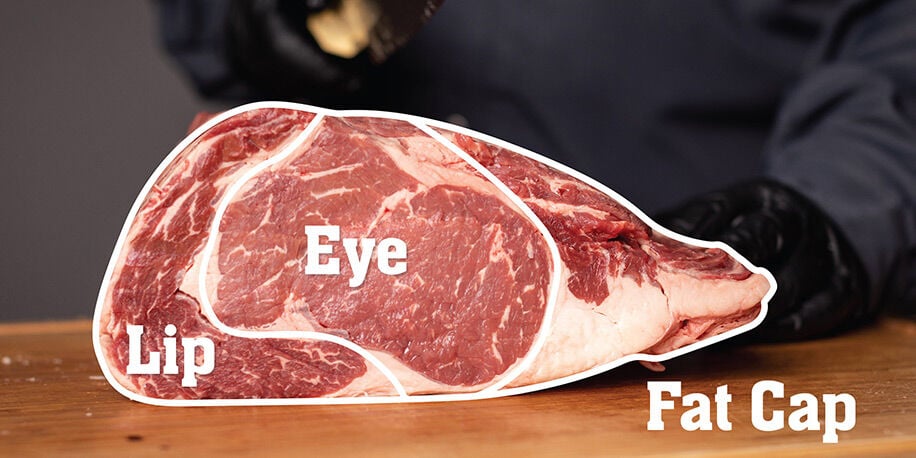
How to select the grade of cut
While prime is also used as a grading system adopted by the USDA, one thing to note is that the name "prime rib" does not mean that your cut is always prime. You'll find there are three USDA prime gradings.
- Select is the lowest grade, you'll find these at your local grocery store or a restaurant chain.
- Choice brings more flavor and tenderness and can be found at most supermarkets and butchers.
- Prime is the highest grade of meat. When comparing the three you will notice an increase of tenderness, juiciness, marbling, and flavor. This is in reference to the meat's fat content.
As you could have guessed, choice has a lower fat content than prime. Choosing a Choice Prime Rib roast is a safe bet when considering price and flavor.
Fun Fact: Did you know that prime rib was named before the USDA prime grading system?
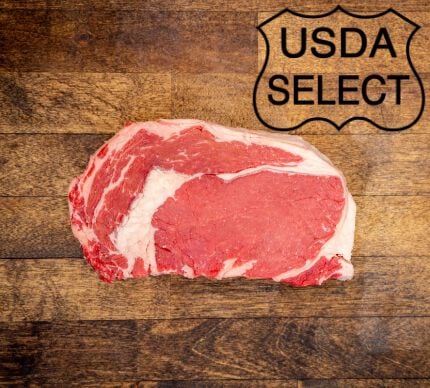
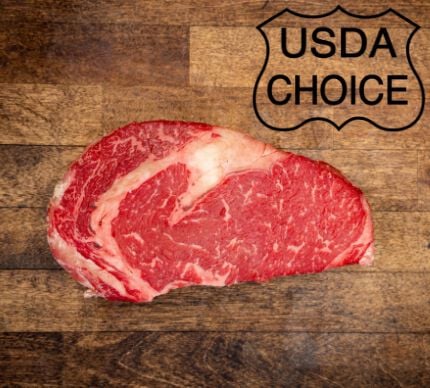
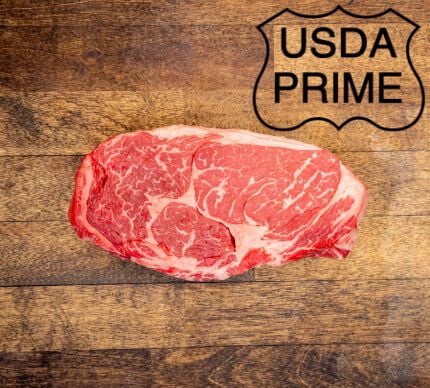
Trimming a standing rib roast
Trimming is always important. Trimming a premium cut like a prime rib is as important as if it was pork ribs. Prime rib roasts need to be presentable and perfect. Whether it is the butcher or yourself trimming here are a few things to keep in mind.
Trimming At The Butcher
Prime Rib vs. Ribeye: Some find the difference between the two a bit tricky. Technically, a prime rib and a rib-eye steak are cut from the same section of the cow. Ribeyes, however, are pre-cut into steaks slices, whereas, the prime rib will come in a roast. If you want to save money and control the size of your slices you maybe want to opt for ribeye's cut to your desired liking.If you find that prime rib roasts yield far too much meat for you and your party to eat, simply ask the butcher to cut it down before handing it over. It's quite common to request a certain number of ribs instead of a whole roast. For example: ribs 6 to 9-better known as the second cut, chuck end, or blade end-are located closer to the shoulder and contain larger chunks of fat. Ribs 10 to 12-also known as the first cut, loin end, or small end-happen to be leaner but more tender.
Pro Tip: A good estimation is cooking 1 lbs. of prime rib person.
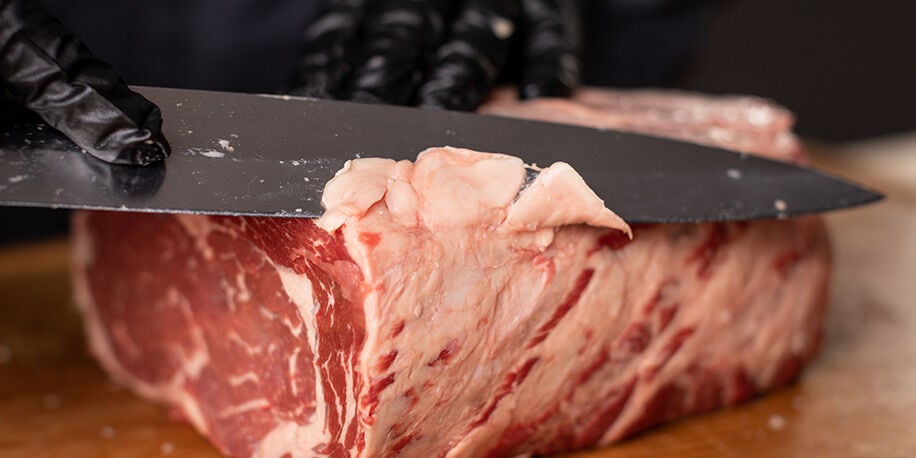
Trimming At Home
Always use a sharp knife. Remember that fat carries flavor. Start by trimming down the hard fat. Don't dig down into the meat, but rather slide your knife across the fat cap trimming away your desired amount. Once you're done. Flip the roast over so the bone side is up. Here you will see a thin layer of the membrane. The membrane is difficult to eat and should be peeled off (some butchers may even do this for you.) If not, locate your bone, then take your knife and slide the blade down the bone, pull back the membrane, and discard.
Should a prime rib be cooked with bones
Bone-in or boneless? That's the real question. This is widely based on personal preference. Here are a few things to keep in mind when making your decision. There are three schools of thought:
Bone-In: A bone-in prime rib will result in larger portions per person. The bones within the rib roast will inevitably determine your slice thickness as you'll have to make your cuts between them. When water bathed, their marrow and connective tissues dissolve making great gravy, braises, and second meals.
Boneless: The crust of your prime rib is arguably the star of a show and to be frank, bones get in the way of that. If you cook with bone-in, then you have to cut off the crust off.
Tying Back On: Your butcher might cut off the bones and tie them back on as a courtesy-keep them! You may cook with them on, but you'll lose the crust and your roast won't brown properly shorting you of the tastiest chemical reaction-the Maillard effect.
The Maillard Reaction is a critical chemical reaction named after French chemist, Louis Maillard. While your meat is cooking, the amino acids in the prime rib react with the sugar compounds. These then create new compounds and intermediates that ultimately provide you with the gorgeous golden coloring, appetizing aromas, and flavor beyond your wildest dream. Opting for bone-in or cooking with the bones tied also abstains 1/3 of the cooking surface from browning. We recommend still getting those cut off bones from the butcher, removing them, and using them separately for other meal additions.
How to Cook Prime Rib
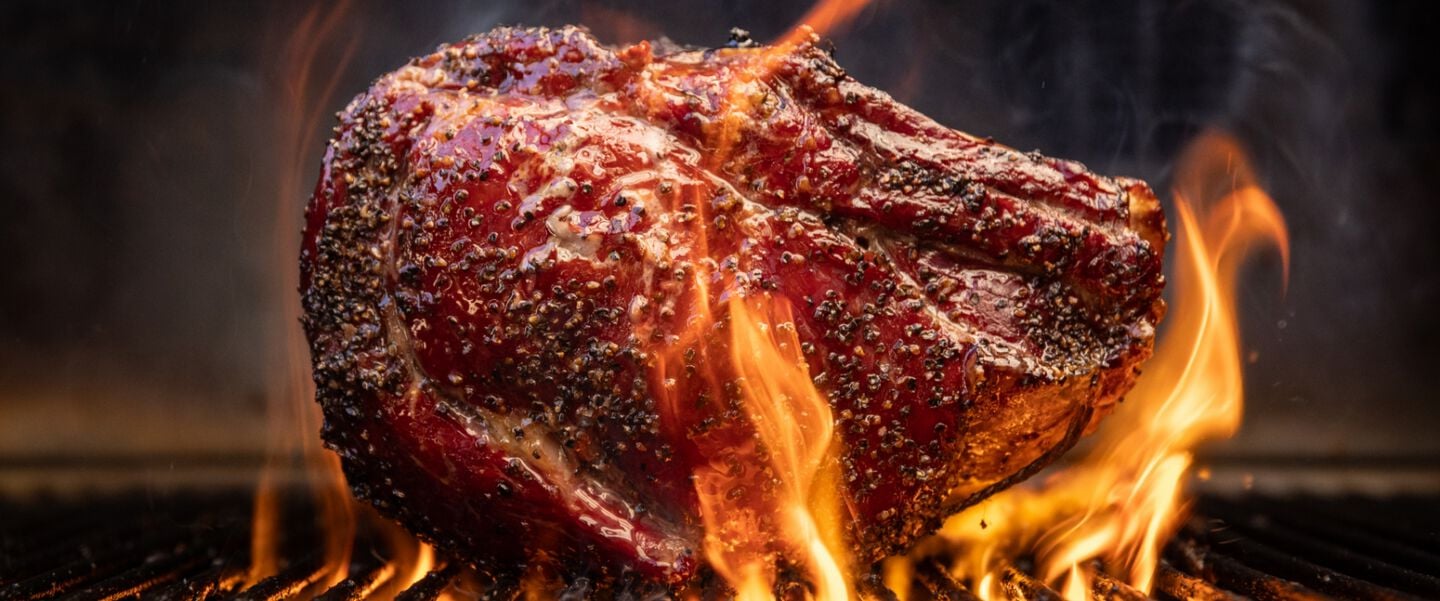
Smoking a Prime Rib Roast
Preheat your pellet grill to around 225°F (Chef Jack likes 235°F.) After dry brining your prime rib, (for a minimum of 12 hours) place your meat in the smoker, cold. Smoke better adheres to cold meat. One of our favorite methods is the reverse sear. To do this, smoke your prime rib until it has reached 20°F below your target temperature. Take it off the smoker and immediately place it on a Sidekick for our final sear. By doing this method you are able to create more flavor. If you don't have a Sidekick Sear or Sidekick Flat Top, remove the roast once it has reached 20°F below the final desired temperature, wrap in foil (to preserve the heat,) and turn your grill up to 400°F. Once your grill is hot, return the roast back onto the grill and finish it off. (Bear in mind that if you choose to leave the roast on the grill while the temp is rising, you'll have layers of brown and gray within the roast-this isn't the desired finish you are wanting.)
How to cook prime rib in the oven
Cooking a prime rib in the oven is quite possibly the most widely used method and works best with smaller roasts. When choosing this cooking technique, we suggest hitting your prime rib with high heat first (between 450 - 500°F.) By searing first, there's an incredible amount of initial heat being placed on the outside of the prime rib, so your meat should be brought to room temperature (before putting into the oven) in order to avoid the dreaded gray ring. While this method provides a flavorful crispy crust base, be careful as to not overcook your meat. Searing at temperatures like these doesn't hold juices but rather creates flavor.
SLOW COOKER / CROCK-POT Prime rib
Another popular prime rib roast cooking method is by slow cooker. Begin by spraying the inside of your crockpot with cooking spray. Start by pouring 1-2 cups of beef broth as a base. Place your prime rib inside the slow cooker (if you have ribs included place the meat ribs side down). Cover and cook on Low for 3 - 5 hours or until you've reached your desired internal temperature. (Medium-rare or 135°F, will be closer to the 3 and a half to 4-hour mark, while medium will be closer to the 4 and a half to 5-hours or 140°F.)
The Art of TYING
Generally, your prime rib roast lays fairly flat. Tying your prime rib will tighten your roast up, allowing it to cook more evenly, and more importantly-avoiding gray ring. So, tie your roast when you can (any kitchen string brand should suffice) and if you don't have the supplies or time, ask your butcher if he or she would be so kind. The trick is to start in the middle and tie your roast about every 1-inch or so to create a rounder piece of meat. A nice uniform shape is going to give you an even cooking surface and optimal airflow around the roast.
what is the best WOOD for smoking prime rib
Different woods burn differently and not just any variety hardwood will do for a prime rib. If you're looking for a classic bold flavor we recommend a Mesquite or Oak pellet base. If you're looking for something on the sweeter side try a Cherry or Apple. And if you're unsure about which hardwood pellets to commit to, the Competition Blend is a safe route.
In our Pro series pellet grills and smokers you can use hardwood chips or chunks. The Woodwind Pro and XXL Pro have our new technology which give significantly more smoke flavor rivaling that of an offset stick smoker. The chips and chunks burn slightly "dirtier". This is where the majority of the flavor comes from. Pellet grills are amazing at flavor and convenience but critics will say they don't provide enough smoke flavor. If you are considering what wood to use and have the capability of picking up a Pro series pellet grill or vertical smoker, the wood you put in the smoke box will determine the ending flavor.
Seasoning a Rib Roast
Prime rib is an expensive cut of meat and for good reason, it's so darn tasty. Many seasonings and spice mixes can get in the way of its natural flavors. Here's a couple that are Camp Chef approved.
AGING AND DRY BRINING
Start by putting your prime rib on a cooling rack over on a sheet pan. This will allow for air to circulate all around the meat. Dry brine by sprinkling kosher salt throughout. Place in the refrigerator or 12 - 36 hours based on your personal preference and/or current cooking situation. All recipes below call for a 10 lbs. prime rib adjust accordingly.
SALT, PEPPER, AND GARLIC
The most common way to season your prime rib is a traditional Texas-style salt and pepper rub. Combine equal parts kosher salt and coarse pepper for a simple, yet tasty way to present your prime rib. Many prime rib purists choose the salt and pepper seasoning method.
PEPPER AND HERB
- 1/4 cup coarse cracked black pepper
- 2 tbs. coarse kosher salt
- 1 1/2 tbs. granulated garlic
- 1 tbs. cornstarch
- 1 1/2 tsp. dry rosemary
- 1 1/2 tsp. dry oregano
- 1 1/2 tsp. dry thyme leaves
Prime Rib BUTTER CRUSTED
(from our friend, Susie at Hey Grill Hey )
- 16 oz. softened butter
- 8 cloves garlic minced
- 2 sprigs rosemary finely minced
- 2 sprigs thyme finely minced
- 2 tsp. salt
- 2 tsp. black pepper
STORE BOUGHT
Mixing and measuring not your pace? There are more than a handful of companies that offer a store-bought, pre-mixed prime rib rub. Check out our line of seasonings including the Y'all Purpose which is very close to a traditional Texas rub. You can also try companies like Snider's and Carl's Gourmet All-Natural Prime Rib.
How long to cook a prime rib
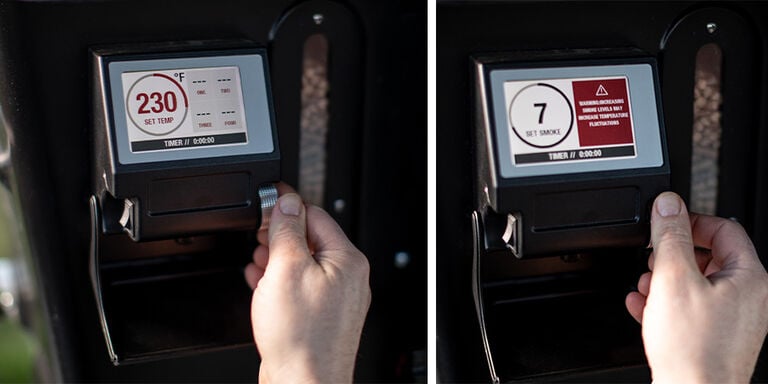
How long does it take to cook a prime rib
The general internet consensus is smoking 25 - 35 minutes/lb. at 225°F. Prime rib cooking temperature is recommended to be between 225°F and 235°F. Depending on size, fat content, connective tissues...nothing can be exact. If you follow our recipe blog, you'll notice that we don't present exact cook times. We know that every piece of meat is different, and cooks differently. We cannot stress enough that the only way to ensure accurate temperature readings is by monitoring your meat's internal temperature using a thermometer or included meat probe. If you're opting for the reverse sear method from above, remove your prime rib once it's reached 20°F prior to your target temperature and open your slide and grill and flame broil for about 35-45 minutes, turning occasionally.
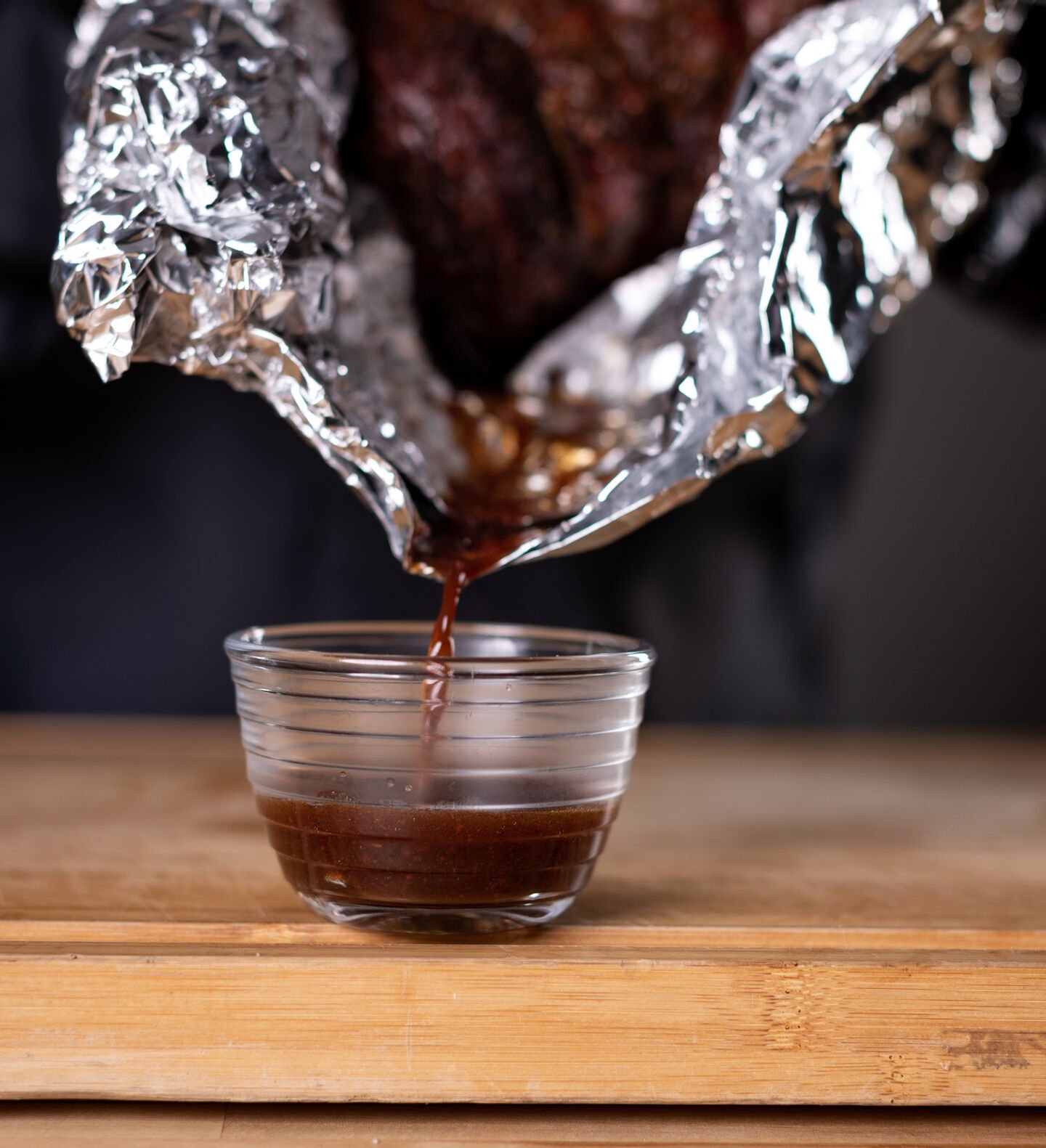
How long should you rest a prime rib
How long do you let a prime rib rest? Allow for at least 30 minutes to rest before slicing and serving. A good 30 - 60 minutes will allow for your prime rib temperature to equalize (rising another 10 - 15°F) and your juices to properly redistribute.
Pro Tip: Loosely wrap your prime rib three times in Aluminum foil. (Air is a great insulator.) Form into a boat to trap juices and save for serving. Pour in a bowl and set aside for later.)
How do you Slice a prime rib
Drum roll please...the moment you and your guests have all been sali-waiting for (salivating/waiting-get it?!) Slicing thickness is a personal preference. Some prefer a thick, English-style cut, while others enjoy an "inch thick" juicy cut. Either way, use a good knife like the one in our Carving Set.
Pro Tip: Immediately after slicing, lightly salt each slice with Kosher salt to intensify the flavors.
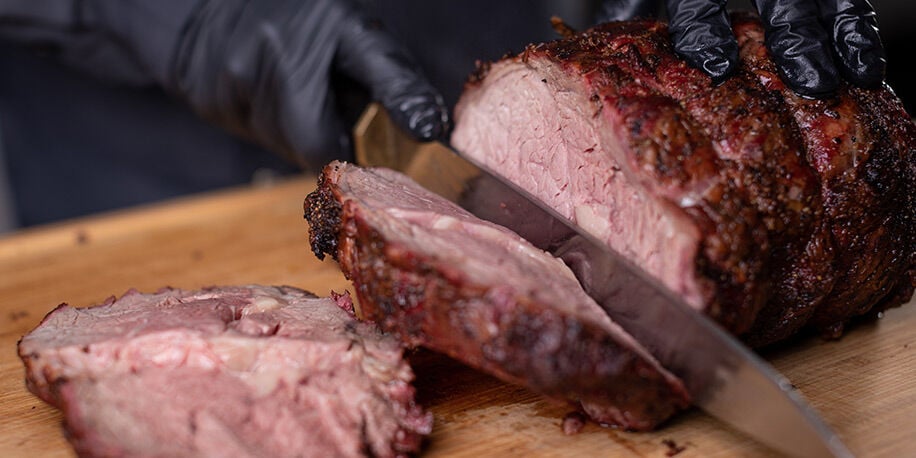
Serving your guests
Even though the prime rib is the prized dish at the table it is important to not overlook the other aspects of a good meal. Sides and sauces can enhance even the best premium meat.
SAUCE & SIDE DISHES
Get creative with your sauces and side dishes. They're completely up to you! Traditionally, prime rib is lightly sprinkled with kosher salt and served with Horseradish sauce. Don't forget to use everything we've got! Remember those juices we set aside? Try dunking or pouring the excess juice over your prime rib to really capture those caramelized flavors. Popular side dishes include seafood (perfect for surf and turf), hasselback potatoes, and most green vegetables.
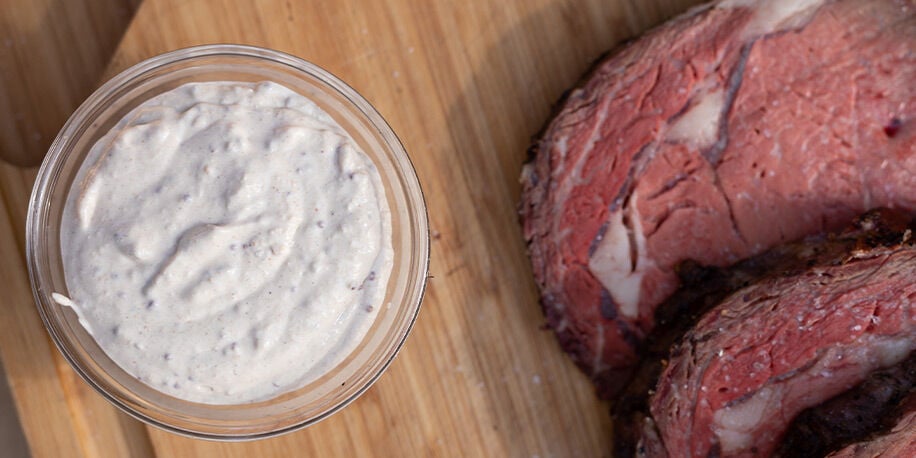
How to store, reheat, and what to do with prime rib leftovers
Store in the refrigerator for up to four to seven days. To reheat, place in a roasting pan, cover with tin foil, and bake in the oven for 20 - 30 minutes at 300°F. Left over prime rib ideas consist of tacos, breakfast hash, stroganoff, or a prime rib sandwich. The sky is the limit when it comes to left overs and prime rib. You can make a prime rib roast and the next week make it into a left over prime rib soup. Otherwise, while it's always best to eat the next day, cooked prime rib can last 2 - 3 months in the freezer before it loses moisture and flavor.
Prime Rib Recipe
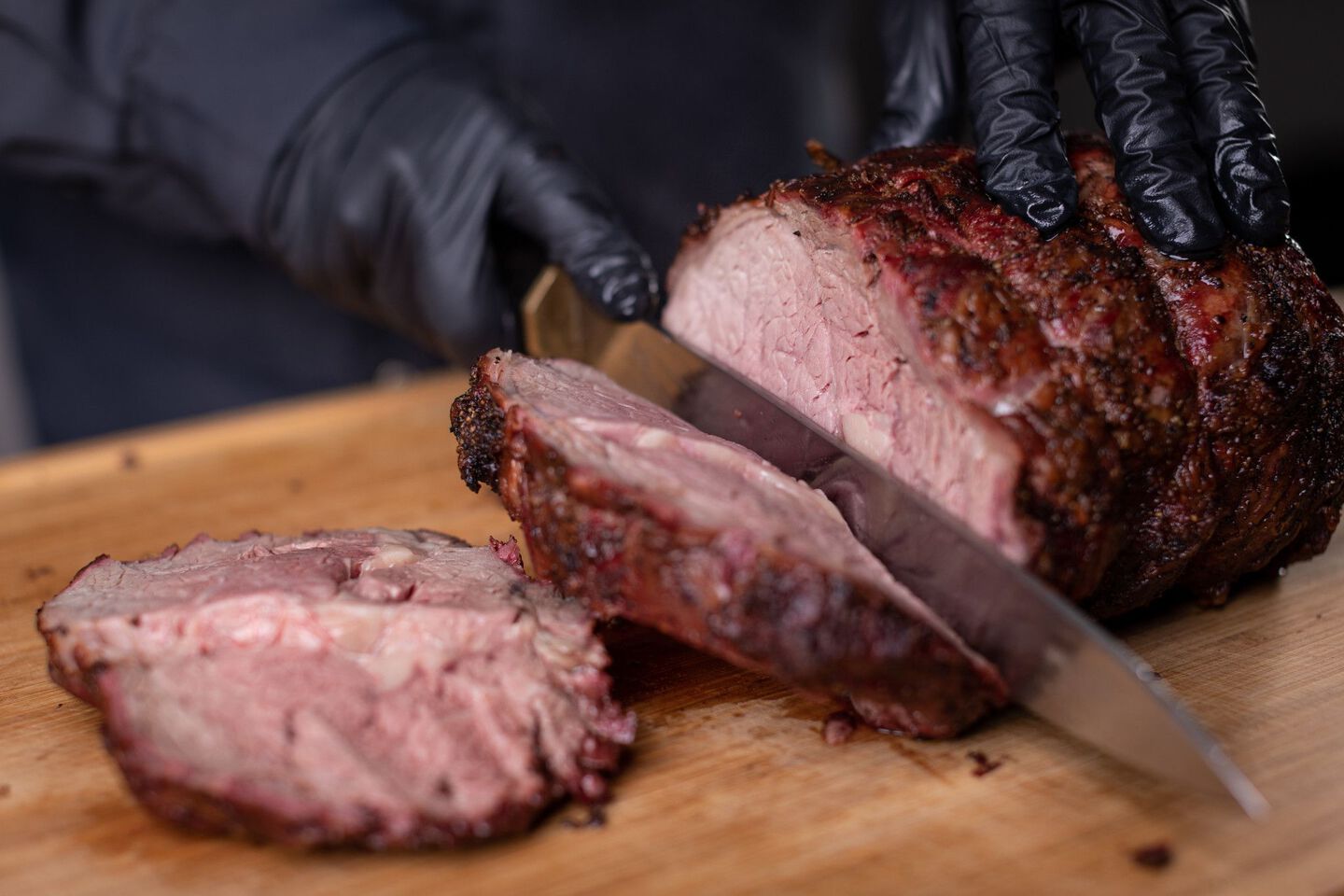
Smoked Prime Rib

prep
10 Hr

cook
Varies

feeds
Varies
Prime rib is always impressive, but that doesn't mean it has to be hard to make. This is an easy recipe for achieving a perfectly pink prime rib that will impress your guests!
What temperature do you cook prime rib at
We recommend cooking prime rib between 220°F and 235°F. This is be cause we use pellet smokers to infuse a natural layer of flavor into the meat. With a lower temperature we can achieve better flavor and keep tender roast.
A CAMP CHEF PRIME RIB
Camp Chef has a variety of products that help make cooking a prime rib seamless. Pick up the 26-inch Bamboo Cutting Board for a large surface great for trimming, seasoning, and slicing your prime rib. All of our pellet grills have the capacity to smoke a prime rib roast-even the Pursuit!
A Camp Chef-style prime rib means more than just using our products-it also provides a sense of community. If you're on Facebook and have a Camp Chef pellet grill, join this customer-ran pellet grill group called Camp Chef Smoker Smokers.










